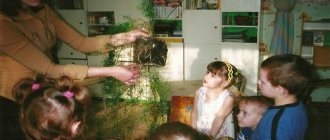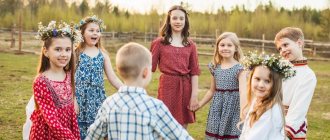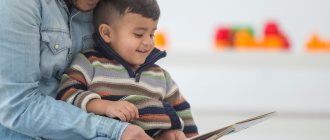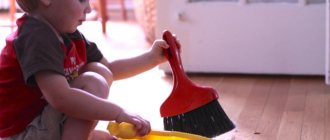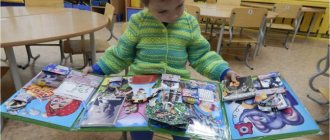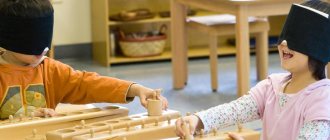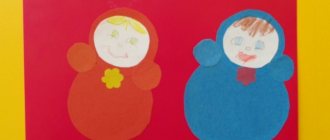I
QUARTER
(September – October – November)
Tasks
Systematization of knowledge about autumn (decreasing day length, lowering air temperature, birds flying away).
Deepening understanding of the diversity of living creatures inhabiting our planet (inhabitants of steppes and deserts - camel, marmot, jerboa, turtle).
Expanding ideas about the state of plants (modified stems, variety of colors of leaves, flowers, variety of fruits and seeds), about the adaptation of seeds to distribution.
Generalization of ideas about air and its properties (invisibility, transparency, movement, movement); about the respiration of plants, fish, other animals, and humans.
Consolidating knowledge about humans (nutrition, breathing, movements, feelings, reproduction and development), about the difference between humans and plants and animals (reasonableness, humanity, labor).
Visual recognition and transformation of geometric figures, recreating them according to presentation and description.
Indication of spatial relationships on a sheet of paper (by symbols); relationship in time (week, month).
Classification of objects and combining them into sets according to three or four criteria.
Comparison of groups of objects, numbers on a visual basis.
Determining the equality of several groups of objects by number (same, same number); inequalities (if one group of objects is larger, then the other...).
Serialization by quantity, size, volume, weight.
Quantitative relations in the natural series of numbers in direct and reverse order. The place of the number among other numbers in the series. Composition of the number of their two smaller numbers.
Independently inventing tasks, puzzles, riddles.
Artistic and creative activities
An idea of decorative art.
Creating three-dimensional and relief images using stamps and materials for attaching elongated, elongated shapes. Mastering origami-type design.
Development of children's imagination in construction from natural materials. Creating interesting crafts by composing and connecting various parts with wire, plasticine, glue, thread.
Formation in children of a conscious attitude to what they read, interest in the inner world of people, and the ability to treat some everyday situations with humor.
Children's use of explanatory and evidentiary speech in accordance with accepted norms of polite speech communication.
Goals: expanding contact between teachers and parents; modeling prospects for interaction for the new academic year; improving the pedagogical culture of parents.
Objectives: consider the age and individual characteristics of children 6-7 years old; introduce parents to the tasks and features of educational work, the tasks of the preschool institution for the new school year.
Form of delivery: presentation
Age 6 - 7 years
Senior preschool age is a period of learning about the world of human relationships, creativity and preparation for the next, completely new stage in his life - studying at school.
Play activity
In role-playing games, children in the preschool group begin to master complex human interactions. Reflecting characteristic life situations. Game actions become more complex and take on a special meaning that is not always revealed to adults. The playing space is becoming more complex. When organizing joint games, children use an agreement, are able to take into account the interests of others, and to some extent restrain emotional impulses.
There is a gradual transition from play as a leading activity to learning.
Construction
Children in the pre-school group have largely mastered construction using building materials.
At this age, children can already master complex addition forms from a sheet of paper and invent their own, but they need to be specially taught this. This type of activity is not only accessible to children, it is important for deepening their spatial understanding. Design from natural materials becomes more complicated.
Visual activities
Images from surrounding life and literary works conveyed by children in visual activities become more complex. The drawings become more detailed and their color range is enriched.
The differences between the drawings of boys and girls become more obvious. Boys willingly depict technology, space, military operations, etc. Girls usually draw female images: princesses, ballerinas, models, etc. Everyday scenes are also common: mother and daughter, room, etc. The image of a person becomes even more detailed and proportional. Fingers, eyes, mouth, nose, eyebrows, chin appear. Clothing can be decorated with various details.
One of the most important features of this age is the manifestation of arbitrariness of all mental processes. (When the child begins to consciously direct and hold on certain objects and objects.)
Development of mental processes
Children continue to develop perceptions, but they cannot always take into account several different signs at the same time. (Size, shape of objects, position in space)
Imagination continues to develop, but it is often necessary to note a decrease in the development of imagination at this age in comparison with the older group. This can be explained by various influences, including the media, leading to stereotypical images of children.
Thinking
Thinking at this age is characterized by a transition from visual-effective to visual-figurative and at the end of the period - to verbal thinking.
1) visual-effective (cognition through the manipulation of objects) (for example, he takes out an object that lies high, placing a chair)
2) visual-figurative (cognition through representations of objects, phenomena, without the use of practical actions.) (eg, can assemble cubes, light puzzles without relying on visualization)
3) verbal-logical (cognition with the help of concepts, words, reasoning, which is associated with the use and transformation of concepts). (eg, can post 6-7 pictures in a row, logically connected to each other).
Children are able not only to solve a problem visually, but also to make transformations of an object, indicate in what sequence the objects will interact, etc.
A preschooler thinks figuratively, but has not yet acquired adult logic of reasoning. The prerequisites for such mental qualities as independence, flexibility and inquisitiveness are being formed. There are attempts to explain phenomena and processes. Children's questions are indicators of the development of curiosity.
Attention becomes voluntary.
At this age, concentration, volume and stability of attention increase significantly, elements of arbitrariness in the management of attention are formed based on the development of speech and cognitive interests.
In some activities, voluntary concentration time reaches 30 minutes. The stability of attention increases - 20-25 minutes, the volume of attention is 7-8 objects. The child may see dual images.
Memory
At 6-7 years of age, memory capacity increases, which allows children to involuntarily remember a fairly large amount of information. Children can independently set themselves the task of remembering something. Using the simplest mechanical method of memorization - repetition.
Speech
The sound aspect, grammatical structure, and vocabulary are developing. Coherent speech develops.
Children's statements reflect both an expanding vocabulary and the nature of sensations that form at this age. Children begin to actively use generalizing nouns, synonyms, antonyms, adjectives, etc.
Dialogue and some types of monologue speech develop. Relationships with peers. Children of senior preschool age are characterized by a predominance of socially significant motives over personal ones. A child can change his point of view, positions as a result of a collision with public opinion, the opinion of another child. The child can perceive the point of view of another person. In the process of assimilation, an active attitude towards one’s own life develops empathy and compassion.
Emotions
The child has developed a stable positive attitude towards himself and confidence in his abilities. He is able to show emotionality and independence in solving social and everyday problems. A critical attitude to the assessment of adults and peers arises. Peer assessment helps the child evaluate himself.
- The child judges moral qualities mainly by his behavior, which either agrees with the norms accepted in the family and peer group, or does not fit into the system of these relations.
- The self-esteem of a child of senior preschool age is quite adequate; it is more typical to overestimate it than to underestimate it. The child evaluates the result of an activity more objectively than behavior.
- As the most important new formation in the development of the mental and personal sphere of a child of 6–7 years of age, the subordination of motives is.
- Awareness of the motive “I must”, “I can” gradually begins to prevail over the motive “I want”.
- In the preschool group, preschool age ends.
- His main achievements are related to the mastery of the world of things as objects of human culture; mastering forms of positive communication with people; development of gender identification, formation of the student’s position.
- By the end of preschool age, the child has a high level of cognitive and personal development, which allows him to successfully study at school in the future.
- A child can and does do not what he wants, but what is needed, what an adult asks or is determined by the rules: he perceives, remembers, thinks, evaluates his activities;
- The first real picture of the world appears, about which the child forms his own opinion;
- The child begins to understand his feelings and experiences fully and communicates this to adults;
- It is very important for children how the people around them treat them;
- There is complete trust in the adult and acceptance of his point of view. Treating adults as the only source of reliable knowledge.
Children 6-7 years old should be able to:
- Distinguish geometric shapes, highlight them in objects of the surrounding world
- Characterize the spatial relationships of objects (right-left, above-under, on-behind, top-bottom, etc.)
- Distinguish the spatial arrangement of figures and parts on a plane
- Classify shapes by shape, size, color
- Distinguish and highlight letters and numbers by shape, size, color
- Mentally find a part of the whole
- Complete the figures according to the diagram, construct them from parts
- Speech.
- Correctly pronounce all the sounds of your native language
- Be able to distinguish and name words with a certain sound
- Be able to determine the place of a sound in a word (beginning–middle–end)
- Divide words into syllables
- Compose words from syllables
- Have an idea of the offer
- Be able to agree words in gender, number and case
- Select synonyms, antonyms
- Use different ways to form words
- Retell familiar fairy tales and stories
- Compose stories and fairy tales based on pictures
- Gross motor skills
- Walk, run, jump straight and firmly
- Accurately catch and throw the ball
- For some time wearing not very light things, large objects
- Fasten buttons, tie shoelaces, etc.
- Fine motor skills
- Draw straight, not shaky lines
- “See the line” and write in it
- See the cells and accurately draw along them
- Educational targets at the stage of completion of preschool age:
- these are social-normative age characteristics of a child’s possible achievements at the stage of completing preschool education.
- They assume the formation of prerequisites for educational activities in preschool children at the stage of completing their preschool education.
- They act as the basis for the continuity of preschool and primary general education.
Top advice for parents
- Be attentive to your child, love him, but do not “tie” him to you, let him have friends, his own social circle. Be prepared to support your child, listen and encourage him. The key to success is friendly and open relationships in the family. It is easier to cope with a problem when it has just arisen and has not yet led to negative consequences.
- Encourage interaction with peers
- Teach your child to manage emotions (using the example of your behavior)
- It is necessary to prepare the child for school in advance (educational games, poetry).
- There is no need to overload with additional activities.
- Praise more.
Physical development
Consolidation of the skills to walk and run easily, run, energetically pushing off from the support.
Development in games, relay races of speed, agility, and general endurance.
Instilling in children a desire to independently organize and conduct outdoor games and exercises with peers and children.
II
QUARTER
(December – January – February)
tasks
Generalization of ideas and typical winter phenomena in inanimate nature, establishing connections between air temperature and the aggregate state of water.
Expanding ideas about life in the Far North and in the tundra (weather, nature, wildlife - polar bear, seal, walrus, etc.); about human adaptation to life in harsh conditions.
Expanding ideas about human use of natural environmental factors: sun, earth, air, water, plants and animals - to meet their needs, strengthen and protect health.
Classification of geometric shapes according to the presence (absence) of features.
Independent drawing up of plans and diagrams. Definition and symbol of time relationships: day - week, week - month, month - year.
Comparability and relativity of quantities. Series by area, depth. Transition dependence: if the first quantity is comparable to the second, and the second – to the third, then the first is comparable to the third.
Determining dependencies when dividing a whole into parts: the more parts the whole is divided into, the smaller each part is, and vice versa.
Addition and subtraction, counting and counting by one when solving arithmetic problems, examples. Formulation of an arithmetic operation and how to perform it.
MAGAZINE Preschooler.RF
PERSPECTIVE PLANNING TAKEN INTO ACCOUNT OF THE FSES IN THE PREPARATORY GROUP.Winner of the all-Russian competition “The most popular article of the month” October 2016
Conditions of the competition:
Authors:
- Taranyuk Maria Vasilievna.
- Evseenko Tamara Ivanovna
Municipal preschool educational institution, a general developmental kindergarten with priority implementation of activities for the artistic and aesthetic development of children No. 109.
Educator. Komsomolsk-on-Amur, Khabarovsk Territory
SEPTEMBER 1 WEEK TOPIC: “MEMORY OF SUMMER”
TASKS: to summarize and systematize children’s knowledge about the characteristic features of summer, about work in nature (in the garden), about summer fun, about the life of the flora and fauna in the summer.
ORGANIZED JOINT EDUCATIONAL ACTIVITIES EDUCATIONAL ACTIVITIES DURING REGULAR MOMENTS
COGNITIVE DEVELOPMENT Cognitive development
Topic: “Memories of Summer”
Etc. tasks: To summarize and systematize the idea of summer according to the main essential features (thunderstorm, rainbow, lightning), about the characteristics of the life of animals in the forest, to clarify the idea of certain types of agricultural labor in the summer; develop the ability to establish a connection between a set of conditions (heat, light, moisture and plant condition); cultivate a desire to share your knowledge and memories with peers.
Mathematics
Etc. tasks: Practice counting within 10; assign numbers from 0 to 10; ordinal counting; practice comparing objects by length and width; repeat the composition of the number; learn to answer in sentences, use plural nouns correctly; develop the ability to understand and independently perform a given task; cultivate endurance.
Pomerantseva str. 14 No. 1, No. 2
Search and research activities.
Topic: "Water Filtration" .
Etc. tasks: to introduce children to the processes of water purification in different ways (sand, rag, blotting paper"; Develop reasoning skills, establish cause-and-effect relationships. Foster a caring attitude towards water.
- D/i “Insects” - to consolidate children’s knowledge about insects, the structure of their body, benefits for humans, nature.
- D/i “When does this happen?” - develop observation skills.
-D/i “Seasons” - teach to see signs of seasonal changes in the weather, plants, animal behavior, life and work of people.
— D/i “Bees and Flowers” — develop attentiveness and interest in nature.
— Lotto “Wildlife” — teach to distinguish different types of plants.
-Butterfly watching
— D/n “Numbers” — repeat numbers from 0 to 10.
- D/i “Similar - not similar” - exercise in comparing objects by shape, color, size.
Regional component
Topic: “Plants of the Khabarovsk Territory” - introduce rose hips, note that in the Far East it is called “Daurian Rose” , cultivate interest in the flora of the Far East.
Experimental activities
“Smell, taste, touch, listen” - to consolidate children’s ideas about the senses, their purpose (ears - to hear, recognize various sounds; nose - to detect smell; fingers - to determine the shape, structure of the surface; tongue - to determine taste).
| Next > |
Artistic and creative activities
Formation of ideas about the individual style of creativity of some artists, graphic artists, sculptors.
An idea of a portrait and its types (self-portrait, children's portrait, family portrait, etc.).
Mastering the methods of working with watercolors and gouache (wet and dry). Mastering the technique of multi-layer and openwork cutting is a more effective way to obtain multiple shapes. Mastering how to work with various tools: scissors, needles, rulers in construction from natural materials.
Using accepted norms of polite verbal communication in interviews (speaking not loudly, not loudly, listening carefully to the interlocutor, asking questions correctly, competently, constructing statements briefly or broadly, focusing on the task of communication).
Objectives of education and training in the preparatory group
TASKS OF EDUCATION AND TRAINING IN A PREPARATORY GROUP
Continue the comprehensive education and development of children, strengthen their health, and improve physical development. Develop cognitive interests, cultivate sustained attention, observation, develop interest in educational activities and the desire to study at school. Develop the ability to analyze and synthesize, self-control, and self-assessment when performing work. Based on expanding knowledge about the environment, cultivate patriotic and international feelings, love for the native land, the Motherland. To reinforce the idea that people of different nationalities live peacefully in our country. Continue to develop labor skills and abilities, cultivate diligence. Continue to improve all aspects of speech; teach children to use both short and common forms of answer, depending on the nature of the question posed, and to complement the statements of their comrades. Prepare children to learn to read and write. Continue to develop phonemic awareness and speech sound analysis skills. To develop the artistic and creative abilities of children in various types of artistic activities. Develop aesthetic perception, sense of rhythm, aesthetic appreciation, artistic taste, aesthetic attitude towards the environment, art and artistic activity. Continue to develop an interest in classical and folk art (musical, visual arts, literature, architecture). Develop organization, discipline, collectivism, respect for elders, caring attitude towards children, the ability and desire to independently unite for joint play and work, to help each other, evaluate the activities of peers kindly. Continue to develop skills in educational activities: listen carefully to the teacher, act according to the plan he proposes, as well as independently plan your actions, carry out the assigned mental task, and correctly evaluate the results of your activities.
Preparatory group for school (from six to seven years old). Age-related characteristics of children's mental development
In role-playing games, children of the seventh year of life
begin to master complex interactions between people, reflecting characteristic significant life situations, for example, a wedding, the birth of a child, illness, employment, etc.
Game actions become more complex and take on a special meaning that is not always revealed to adults. The playing space is becoming more complex. It can have several centers, each of which supports its own storyline. At the same time, children are able to monitor the behavior of partners throughout the playing space and change their behavior depending on their place in it. Thus, the child already addresses the seller not just as a buyer, but as a buyer-mother or buyer-driver, etc. The performance of a role is emphasized not only by the role itself, but also by the part of the playing space in which this role is played. For example, playing the role of a bus driver, a child commands passengers and obeys the traffic police inspector. If the logic of the game requires the emergence of a new role, then the child can take on a new role during the game, while maintaining the role taken previously. Children can comment on the performance of the role by one or another participant in the game.
Images from surrounding life and literary works conveyed by children in visual activities become more complex. The drawings become more detailed and their color range is enriched. The differences between the drawings of boys and girls become more obvious. Boys willingly depict technology, space, military operations, etc. Girls usually draw female images: princesses, ballerinas, models, etc. Everyday scenes are also common: mother and daughter, room, etc. With the right pedagogical approach Children develop artistic and creative abilities in visual arts.
The image of a person becomes even more detailed and proportional. Fingers, eyes, mouth, nose, eyebrows, chin appear. Clothing can be decorated with various details. Children in the pre-school group have largely mastered construction using building materials. They are fluent in generalized methods of analyzing both images and buildings; not only analyze the main design features of various parts, but also determine their shape based on the similarity with familiar three-dimensional objects. Free buildings become symmetrical and proportional, their construction is carried out on the basis of visual orientation. Children quickly and correctly select the necessary material. They quite accurately imagine the sequence in which the construction will be carried out, and the material that will be needed to complete it; are able to carry out constructions of varying degrees of complexity, both according to their own plans and conditions.
At this age, children can already master complex addition forms from a sheet of paper and invent their own, but they need to be specially taught this. This type of activity is not only accessible to children, it is important for deepening their spatial understanding.
Design from natural materials becomes more complicated. Children already have access to holistic compositions based on a preliminary plan, which can convey complex relationships and include figures of people and animals in various conditions.
Children continue to develop perceptions, but they cannot always take into account several different signs at the same time. Figurative thinking develops, but the reproduction of metric relationships is difficult. This can be easily checked by asking children to reproduce on a piece of paper a sample on which nine dots are drawn that are not located on the same straight line. As a rule, children do not reproduce metric relationships between points: when drawings are superimposed on each other, the points of the child's drawing do not coincide with the points of the sample.
Generalization and reasoning skills continue to develop, but they are still largely limited to visual signs of the situation.
Imagination continues to develop, but it is often necessary to note a decrease in the development of imagination at this age in comparison with the older group. This can be explained by various influences, including the media, leading to stereotypical images of children.
Attention continues to develop, it becomes voluntary. In some activities, voluntary concentration time reaches 30 minutes.
Children continue to develop speech: its sound side, grammatical structure, vocabulary. Coherent speech develops. Children's statements reflect both the expanding vocabulary and the nature of generalizations that are formed at this age. Children begin to actively use generalizing nouns, synonyms, antonyms, adjectives, etc. As a result of properly organized educational work, children develop dialogic and some types of monologue speech.
In the preschool group, preschool age ends. His main achievements are related to the mastery of the world of things as objects of human culture; children master forms of positive communication with people; Gender identification develops and the student’s position is formed.
By the end of preschool age, the child has a high level of cognitive and personal development, which allows him to successfully study at school in the future.
Physical development
Improving coordination of movements and balance. Fostering honesty, friendliness, and independence in the process of outdoor games and performing various physical exercises.
III
QUARTER
(March – April – May)
tasks
Generalization of ideas and typical spring phenomena in inanimate nature.
Expanding knowledge about the life of living beings in various ecological systems (forest, meadow, pond, park, vegetable garden); about the manifestations of positive and negative mutual influences of organisms in ecosystems.
Clarification of the basic rules of human behavior in ecosystems (“Red Book”; the possibilities of life in the environment of inanimate nature, among living organisms).
Selection by sample and by the name of objects of a certain shape. Transformation of geometric shapes according to conditions using a ruler, compass, templates, stencils.
Designation of spatial relationships on a plan, diagram; relationships in time (minute - hour, week - month, month - year).
Composition of a number from several smaller numbers. Adding and subtracting numbers (techniques of counting and counting by 2) when solving arithmetic problems. Find the next and previous number of each number from 1 to – 30).
Artistic and creative activities
Development of a consistent holistic artistic perception of works of art, the ability to express evidence-based judgments and evaluate what is seen.
Mastering the methods of applying different color spots: pen work, shading, shading, graphography; creating sketches.
The use of cutting techniques in plot appliqué in collective works; mastering the papier-mâché technique.
Improving skills in constructing three-dimensional crafts from ready-made paper patterns (reading symbols and accurately following them in operational maps).
Development of children's creative abilities in role-playing games based on literary plots, in dramatizations, dramatization and other types of performing activities.
Developing the ability to select the most interesting and significant events and episodes for creative stories, finding a suitable form of transmission, including descriptions of nature and the surrounding reality in the narrative.
Social and moral education
Forming an understanding that friendly relations between peers depend on the behavior of each child, the concept of the inadmissibility of indifference, ridicule, nicknames, etc. in relation to other children.
Reinforcing the rules of behavior with adults and peers, rules of behavior in public places (on the street, in transport, cinema), traffic rules, ways of addressing strangers.
Understanding of safety precautions when handling fire and electrical appliances; idea of basic assistance in case of injury, etc.
Awareness of your abilities in finding interesting types of work.
Approximate volume of educational load in a preschool educational institution, taking into account SanPiN 2.4.1.3049-13 and the draft Federal State Educational Standard for Preschool Education
Approximate volume of educational load in a preschool educational institution
taking into account SanPiN 2.4.1.3049-13 and the draft Federal State Educational Standard
A rational daily routine is the basis for the health and upbringing of children. Strict adherence to the regime helps regulate the child’s basic physiological needs, stability of behavior, teaches organization and activity, and helps maintain stable performance.
Organized educational activities of children of primary and secondary preschool age are carried out in the process of involving them in various types of children's activities: play, cognitive research, perception of fiction and folklore, self-service and basic household work, construction from various materials, visual arts, music. The teacher doses the volume of educational load taking into account sanitary and epidemiological rules and regulations.
Educational activities with children of senior preschool age are carried out in the process of involving them in various types of children's activities, including in the form of classes. Particular attention must be paid to the hygiene of organizing and conducting classes with children, ensuring a rational combination of mental and physical activity, as well as sufficient physical activity of the child during the day. Teachers dose the educational load taking into account sanitary and epidemiological rules and regulations.
According to the current SanPiN 2.4.1.3049-13
The duration of continuous direct educational activity for children from 3 to 4 years old is no more than 15 minutes, for children from 4 to 5 years old - no more than 20 minutes, for children from 5 to 6 years old - no more than 25 minutes, and for children from 6 to 7 years old - no more than 30 minutes. The maximum permissible amount of educational load in the first half of the day in the junior and middle groups does not exceed 30 and 40 minutes, respectively, and in the senior and preparatory groups - 45 and 1.5 hours, respectively. In the middle of the time allotted for continuous educational activities, a physical education session is held. Breaks between periods of continuous educational activity are at least 10 minutes.
Educational activities with children of senior preschool age can be carried out in the afternoon after a nap. Its duration should be no more than 25 - 30 minutes a day. In the middle of directly educational activities of a statistical nature, physical education minutes are held. Educational activities that require increased cognitive activity and mental stress of children should be organized in the first half of the day. To prevent children from becoming tired, it is recommended to conduct physical education, music, rhythm classes, etc.
Age-related educational loads in accordance with SanPiN 2.4.1.3049-13
| Age Criteria | 3-4 years | 4-5 years | 5-6 years | 6-7 years |
| No more | ||||
| 30 min. | 40 min. | 45 min. in the first half of the day | 1.5 hours in the first half of the day | |
| 25 minutes in the afternoon | 30 minutes in the afternoon | |||
| Number of conditional hours (NCH) per week | 10 | 10 | 13 | 14 |
| Number of conditional hours (NCH) per year based on 28 academic weeks | 280 | 280 | 364 | 392 |
| Total astronomical time GCD per week (in hours) | 2 hours 30 minutes | 3 hours 20 minutes | 5 hours 25 minutes | 7 hours |
| Total astronomical time GCD per year (in hours) | 70 hours | 93 hours 20 minutes | 140 hours | 196 hours |
| Maximum permissible volume of weekly educational load according to SanPiN | 2 hours 30 minutes 150 min. | 3 hours 20 minutes 200 min. | 5 hours 50 minutes 350 min. | 10 o'clock 600 min. |
The approximate volume of the weekly educational load at the institution for the 2013 – 2014 academic year. year
(directly educational activities)
| Educational areas | Program area | Name | Time (number of hours per week) | |||
| from 3 to 4 years | from 4 to 5 years | Senior preschool age | ||||
| from 5 to 6 years | from 6 to 7 years | |||||
| Physical development | Development of a culture of movement and health work. Mastering the basic norms and rules of a healthy lifestyle. | Physical Culture | 45 min | 60 min. | 75 min. | 90 min. |
| Cognitive development | Development of a culture of knowledge. Formation of cognitive actions, formation of cognition. | Formation of elementary mathematical concepts | 15 minutes | 20 minutes. | 25 min. | 60 min. |
| Cognitive development | 15 minutes | 20 minutes | 25 min | 30 min | ||
| Social and communicative development | Development of communication and interaction of the child with adults and peers. Development of social and emotional intelligence. | Construction/artwork | 25 min | 30 | ||
| Manual labor | 25 min | |||||
| Artistic and aesthetic development | Development of artistic and aesthetic culture. The formation of an aesthetic attitude towards the surrounding world | Music | 30 min | 40 min. | 50 | 60 |
| Visual activities | 15 minutes | 20 minutes. | 50 | 60 | ||
| Modeling | 15 minutes | 20 minutes. | — | — | ||
| Speech development | Development of a culture of communication. Mastery of speech as a means of communication. | Speech development | 15 minutes | 20 minutes. | 25 | 30 |
| Literacy training | 25 | 60 | ||||
| TOTAL: | 2h. 30 min. | 3 hours 20 minutes | 5 hours 25 minutes | 7 o'clock | ||
| Maximum allowed according to SanPin: | 2 hours 30 minutes | 3 hours 20 minutes | 5 hours 50 minutes | 10 hours |
Variable (modular) part of the program.
In accordance with the priority of the establishment and ensuring equal starting opportunities for pupils, children's interest groups are included in the educational process. Due to the fact that both parts of the Program are recommended to be kept in the general logic and its implementation is carried out during the entire stay of the pupils in the preschool educational institution, circle work can be organized both in the first half of the day and in the afternoon.
The following additional services are provided:
| Development direction | Educational services | Age group | Supervisor |
| 1. Physical | "The big guy" | Senior preschool age (6-7 years) | Physical education instructor 2 sq. category |
| 2. Cognitive-speech | "Why" | Senior preschool age (5-6 and 6-7 years old) | Group teachers |
| "Rechetsvetik" | Senior preschool age (5-6 years) | Teacher speech therapist | |
| "We speak correctly" | Senior preschool age (6-7 years) | Teacher speech therapist | |
| "Zukovichok" | Senior preschool age (5-6 years) | Teacher speech therapist | |
| 3. Artistic and aesthetic | "Yugorchata" | Senior preschool age (6-7 years) | Musical director |
| "Okay" | Senior preschool age (5-6 years) | Musical director |
Children of senior preschool age visit the speech correction room 2 times a week; carried out as individual
as well as subgroup classes. The content of the correctional program “Program for training and education of children with phonetic-phonemic speech underdevelopment” is implemented in individual lessons with children with deviations in speech development.
Get text
